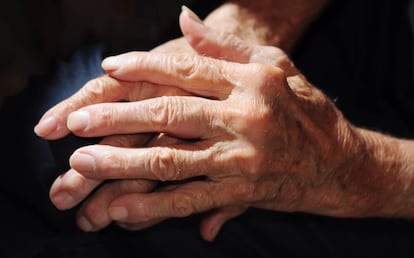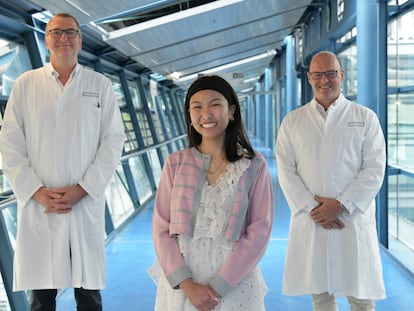Osteoarthritis: An incurable disease that affects 500 million people
Aging, mechanical wear and tear of the joints and metabolic issues like obesity cause the painful and debilitating condition. Scientists are researching biomarkers to detect it early and drugs to slow its progression

A kind of gelatinous sponge bears the burden of articulating the human body’s bones. For example, to move the knee, the femur dances on a bed of menisci that cushion the friction against the bone below, the tibia. This cartilage is elastic to bear the weight of rotation and movement; it adapts to a movement’s needs and then returns to its natural position when the leg is at rest. But these joint pads also tire and age, while overload and lifestyle habits can erode them to the point that they disappear. That’s called osteoarthritis, a disease that has no cure. The condition is extremely debilitating and affects more than 500 million people worldwide: it starts as a silent disease that doesn’t cause pain or symptoms for around 20 years; by the time it is diagnosed, the cartilage is so worn out that not much can be done. Scientists are researching biomarkers to detect the disease in its early stages and drugs to slow its progression.
Osteoarthritis diagnoses have skyrocketed by 113% over 30 years. In 1990, an estimated 248 million people had osteoarthritis; in 2020, that figure rose to 528 million, according to a study published in Arthritis and Rheumatology, the American Society for Rheumatology’s journal. An aging population partly explains this increase, but other factors also play a role.
Francisco Blanco, the coordinator of the Rheumatology Research Group at A Coruña’s Institute for Biomedical Research (Inibic) and a leading researcher of osteoarthritis, explains that there are mechanical causes, resulting from joint overload, that lead to osteoarthritis. This is not always a function of age; it also depends on the intensity of joint wear and tear, as in the case of elite athletes, for example: “The tissue has a [certain amount of] resistance, and a time comes when that’s destroyed. Mechanical overload produces a series of substances that induce the [cartilage] cell to go into apoptosis,” an active death process in which the cells decide to “commit suicide,” the researcher explains.
Aging is linked to these mechanical causes, but Blanco points out that there’s another factor at play: “As time goes by, alterations occur in the mitochondria of cells that produce certain substances, such as oxygen free radicals, that also end up causing apoptosis.” A study by the Spanish Society of Rheumatology showed that 30% of Spaniards over 40 years old suffer from osteoarthritis, and the disease is more common in women. That figure increases with the passage of time; more than half of people over the age of 80 suffer from the disease.
Researchers have also discovered that classic mediators of inflammation exist in osteoarthritis; these are the same ones that appear in other ailments, like rheumatoid arthritis. The mediators of inflammation showed up “at a lower level, but they were still present and induced cell death from inflammation,” explains Blanco, who’s a spokesperson for the Spanish Society of Rheumatology. In osteoarthritis, there’s usually a lesser degree of inflammation that’s concentrated in the joint – it hurts when moving and stops when at rest – while in arthritis there’s systemic inflammation (it can even affect other organs, such as the lungs or the heart) and usually causes pain at rest.
Experts are also exploring a metabolic cause of osteoarthritis, says Blanco: “We’ve always known that obese people have more osteoarthritis of the knee, but it had been attributed to a mechanical effect, because the joint had to carry more weight. Now, we know that there’s also a metabolic effect on cartilage: atherosclerosis occurs and there’s plaque in the cartilage.” That creates thicker tissue; biomechanically, in addition to being impractical, it can be cytotoxic.
In practice, the outcome is essentially the same: “Cartilage begins to wear down and the bone is exposed. Bone is a rigid structure that doesn’t cushion impact well; when bones rub against each other, the body’s defense mechanism for dealing with that is to produce more bone, which causes sclerosis: the bone becomes harder, while the joint deteriorates, hurts more and doesn’t move well,” says Blanco. Experts explain that osteoarthritis of the hips and knees is the leading cause of the functional inability to walk among people over 70 years old, and over half of all affected patients lack a way to control pain.
Osteoarthritis doesn’t have a cure, and there aren’t any drugs to slow its progression. Scientists are testing drugs to control the disease, but they haven’t found the root of the problem; they’re also trying to build new cartilage through tissue engineering, but none of it resembles that of a healthy human. Doctors tackle symptoms with anti-inflammatory drugs and prescribe analgesics to relieve pain.
Primary care physicians – who, along with rheumatologists, monitor these patients – also recommend that people suffering from osteoarthritis engage in physical activity, says David de la Rosa, a member of the Spanish Society of Family and Community Medicine’s Rheumatologic Diseases group: “Pain prompts these patients to go to the doctor. We have to empower them, explain the disease’s causes and evolution, tell them that there’s no cure, but that we’re going to try to prevent its progression. We have to explain to them that treatment is important, but that’s only one part of it: they also need physical exercise.” The physician points out that, while it is important to find “a drug that allows us to control the disease or prevent its progression,” it’s even more important to focus on “non-pharmacological approaches and to improve information and knowledge about the disease and care pathways.”
Luz Cánovas, a member of the Spanish Pain Society’s Working Group on Musculoskeletal Pain, notes that osteoarthritis “involves limited movement in 80% of the cases, and patients are in pain for most of the year.” That pain is only attenuated with rest; in a kind of vicious cycle, that can lead to a more sedentary lifestyle, which doesn’t support the approach to treating this disease or preventing other ones such as obesity. “Patients are most concerned about experiencing pain and functional limitations,” the specialist explains. However, she points out that there are preventive measures, such as weight loss if a patient is obese or overweight, and personalized exercises for improving mobility (cycling, yoga, swimming, etc.), as well as anti-inflammatory drugs, analgesics and even thermal radiofrequency techniques to reduce pain.
Late detection
Blanco says that late diagnosis is the biggest obstacle to treating osteoarthritis. By the time the disease emerges, the cartilage has already been suffering for about 20 years; because the tissue isn’t vascularized and doesn’t have nerves, it doesn’t bleed or hurt until it’s too late. “Now, with new treatments, such as platelet-rich plasma and growth factors, you can delay the problem for three or five years, but you can’t resolve it. We believe that the solution needs to focus on the 20 years when the disease is latent; surely, treatments or tissue engineering can control the disease in its early stages.”
Scientists are currently researching biomarkers that can predict the disease or detect it early. At present, 20 genes and proteins are associated with and signal the ailment; carriers have a greater risk of developing the disease. But we still need to learn the origins and initial causes of osteoarthritis, as well as figure out which gene plays the most important role in it.
May de Andrés, a biologist and the Miguel Servet researcher at Inibic, focuses on preventing the disease from emerging altogether. For that reason, she works on the epigenome, the chemical substances that stick to genes and are conditioned by one’s environment and life habits; the epigenome can modulate a gene’s activity, turning it on or off like a switch: “Osteoarthritis has always been seen as an age-related degenerative disease for which nothing can be done. That’s not true. The fact that other non-genetic factors influence the disease can lead to drugs for reversing it.” To that end, the researcher has launched a study at multiple Spanish research centers to examine the Mediterranean diet’s effects on osteoarthritis: the study will give a group of participants olive oil and nuts for a year to explore how they affect the joints as compared to the control group. “We want to see which epigenetic marks change when you eat a healthier diet, which could serve as markers in the future. We have to try to stop the erosion of cartilage earlier. Prevent, don’t repair.”
Tu suscripción se está usando en otro dispositivo
¿Quieres añadir otro usuario a tu suscripción?
Si continúas leyendo en este dispositivo, no se podrá leer en el otro.
FlechaTu suscripción se está usando en otro dispositivo y solo puedes acceder a EL PAÍS desde un dispositivo a la vez.
Si quieres compartir tu cuenta, cambia tu suscripción a la modalidad Premium, así podrás añadir otro usuario. Cada uno accederá con su propia cuenta de email, lo que os permitirá personalizar vuestra experiencia en EL PAÍS.
¿Tienes una suscripción de empresa? Accede aquí para contratar más cuentas.
En el caso de no saber quién está usando tu cuenta, te recomendamos cambiar tu contraseña aquí.
Si decides continuar compartiendo tu cuenta, este mensaje se mostrará en tu dispositivo y en el de la otra persona que está usando tu cuenta de forma indefinida, afectando a tu experiencia de lectura. Puedes consultar aquí los términos y condiciones de la suscripción digital.
More information
Últimas noticias
The complicated life of Francesca Albanese: A rising figure in Italy but barred from every bank by Trump’s sanctions
Half of Scotland is in the hands of 420 property owners
Reinhard Genzel, Nobel laureate in physics: ‘One-minute videos will never give you the truth’
Pinochet’s victims grapple with José Antonio Kast’s rise in Chile
Most viewed
- Pablo Escobar’s hippos: A serious environmental problem, 40 years on
- Why we lost the habit of sleeping in two segments and how that changed our sense of time
- Charles Dubouloz, mountaineering star, retires at 36 with a farewell tour inspired by Walter Bonatti
- Trump’s obsession with putting his name on everything is unprecedented in the United States
- The Florida Keys tourist paradise is besieged by immigration agents: ‘We’ve never seen anything like this’











































